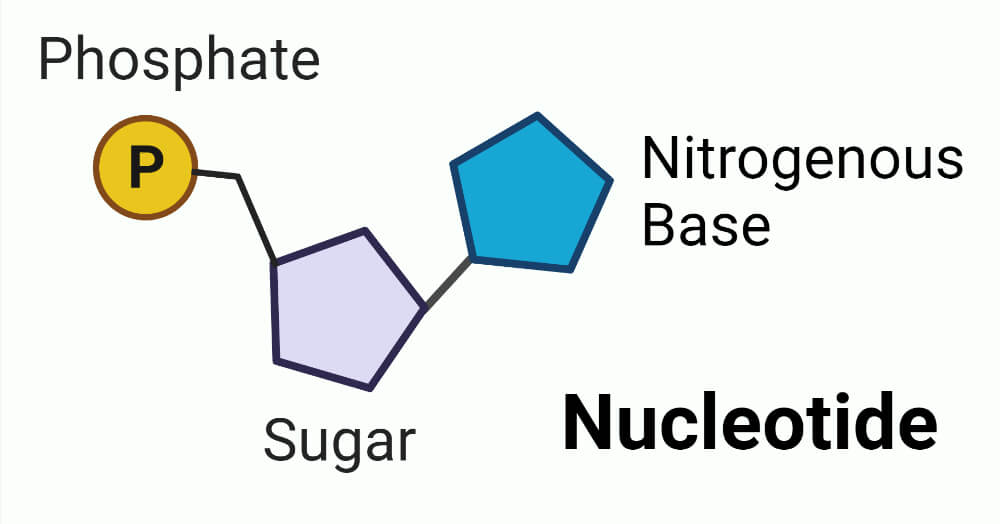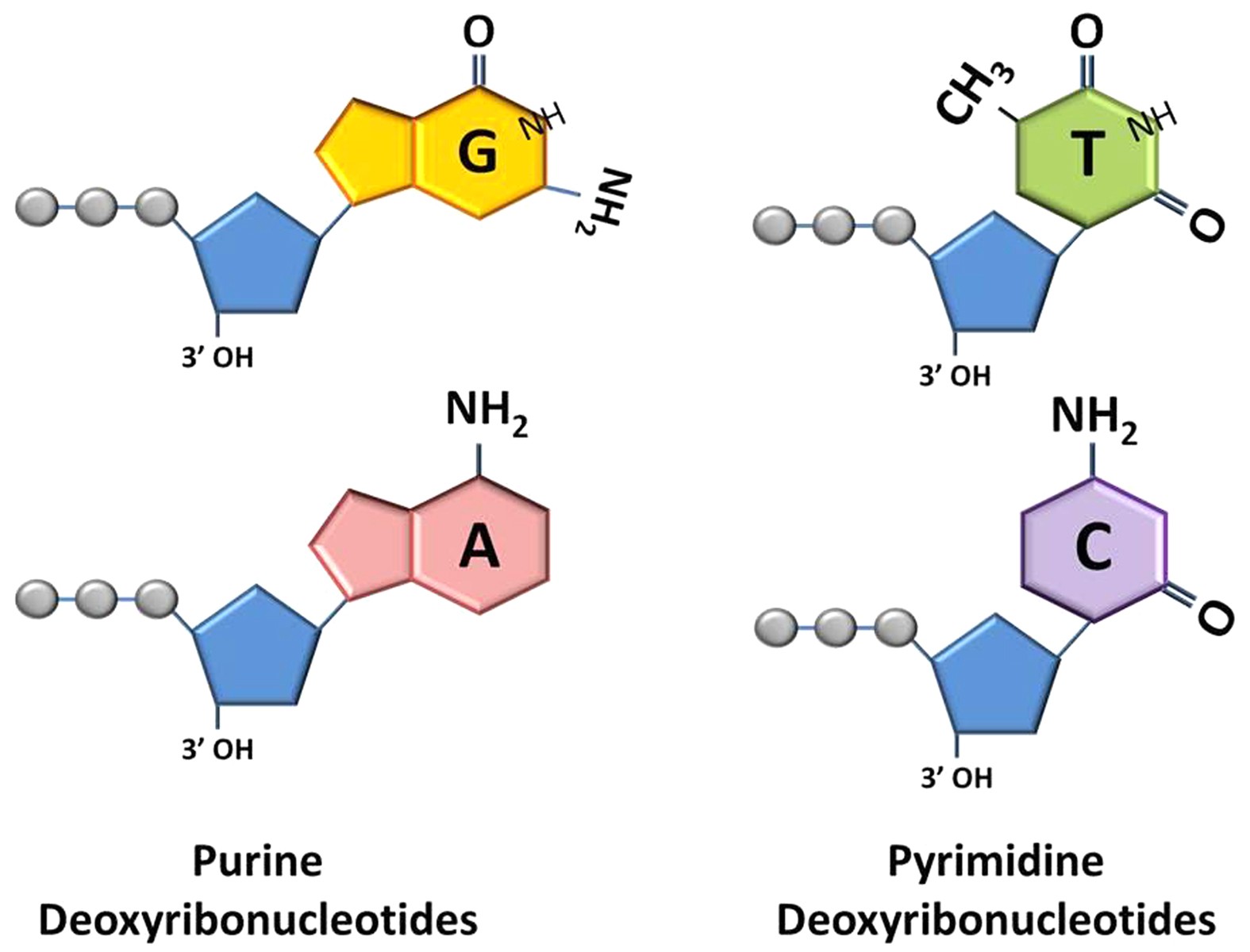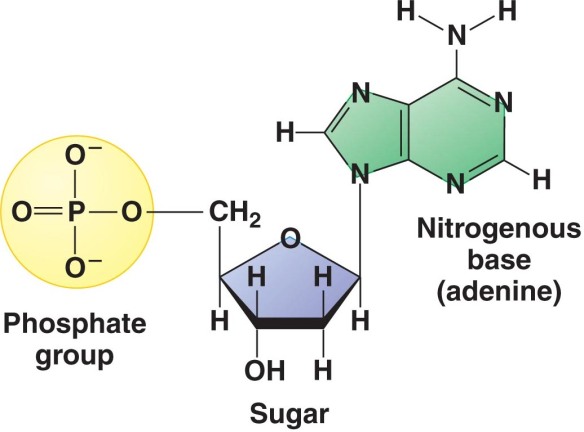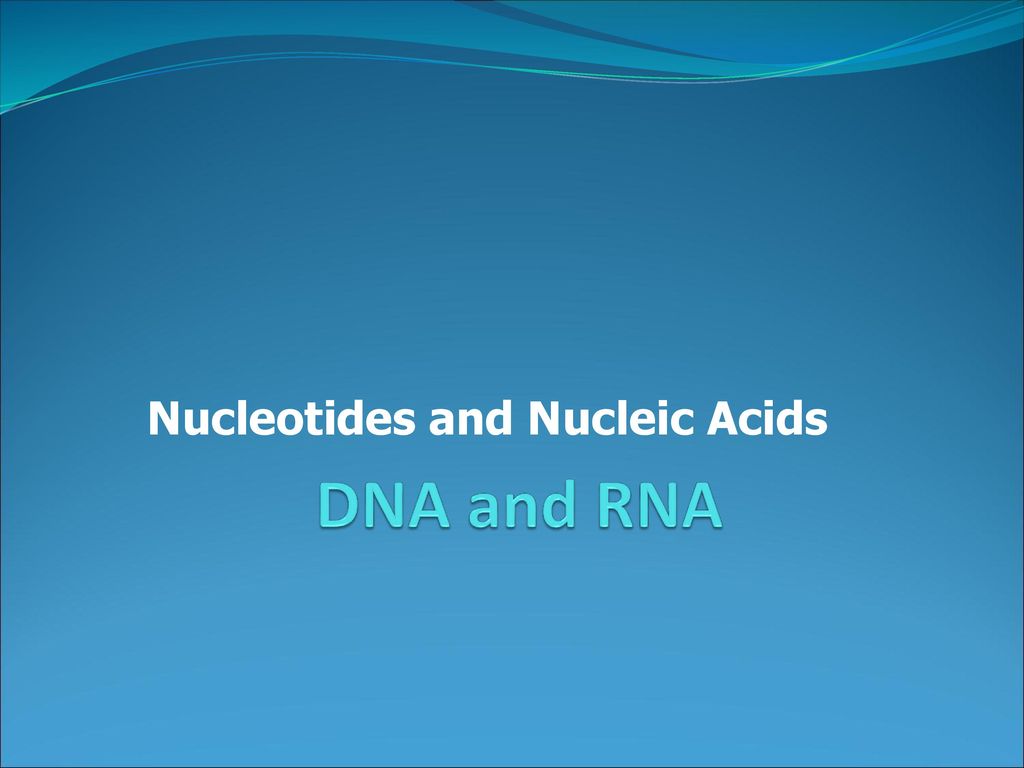Nucleotides are the fundamental building blocks of nucleic acids, such as DNA and RNA. These molecules play a crucial role in storing and transmitting genetic information, as well as in various cellular processes. Understanding the structure and function of nucleotides is essential in comprehending the molecular basis of life.
What is Nucleotide?
A nucleotide is a complex molecule composed of three main components: a nitrogenous base, a sugar molecule, and a phosphate group. The nitrogenous base can be either a purine (adenine or guanine) or a pyrimidine (cytosine, thymine, or uracil). The sugar molecule is either a ribose (in RNA) or a deoxyribose (in DNA). The phosphate group consists of one or more phosphate molecules.
The arrangement of these components within a nucleotide is crucial for its structure and function. The nitrogenous base is attached to the 1′ carbon of the sugar molecule, while the phosphate group is bonded to the 5′ carbon. This arrangement forms a nucleoside, which is the base-sugar unit of a nucleotide. The addition of the phosphate group transforms the nucleoside into a nucleotide.

Difference Between Nucleotide and Nucleoside
It is important to distinguish between nucleotides and nucleosides. A nucleoside is composed of a nitrogenous base and a sugar molecule, whereas a nucleotide contains a nucleoside along with one or more phosphate groups. Nucleotides are the building blocks of nucleic acids, while nucleosides play various roles in cellular metabolism and signaling.
| Parameter | Nucleotide | Nucleoside |
| Structure | It consists of a nitrogenous base, one to three phosphate groups, and sugar-like deoxyribose and ribose | It consists of a nitrogenous base that has an attachment to sugar in a covalent manner without the phosphate group |
| Medical Relevance | Nucleotides that are dysfunctional lead to the onset of cancer due to the accumulation of damaged DNA | Use of several nucleoside analogues takes place in medicine as anticancer agents or antiviral |
| Composition | It consists of nucleoside in addition to one or more phosphate groups | It consists of a nitrogenous base in addition to Pentose sugar |
| Role in Nucleic Acids | It makes covalent bonds with other nucleotides to result in the formation of nucleic acid strand | It undergoes phosphorylation to result in the formation of nucleotides |
| Examples | Uridine monophosphate, guanosine monophosphate, cytidine monophosphate, adenosine monophosphate, thymidine monophosphate | Uridine, guanosine, cytidine, adenosine, thymidine |
Types of Nucleotides
There are different types of nucleotides, characterized by the specific nitrogenous base they contain. The four nitrogenous bases found in DNA are adenine, guanine, cytosine, and thymine. In RNA, thymine is replaced by uracil. These bases can be further classified into two groups based on their chemical structure: purines and pyrimidines.

Adenine
Adenine is a purine base found in both DNA and RNA. It forms two hydrogen bonds with thymine in DNA or with uracil in RNA. Adenine plays a crucial role in the structure and function of nucleic acids, as well as in cellular processes such as energy transfer.
Guanine
Guanine is another purine base found in DNA and RNA. It forms three hydrogen bonds with cytosine. Guanine is involved in base pairing and contributes to the stability and structure of nucleic acids. It also plays a role in cellular signaling and energy transfer processes.
Cytosine
Cytosine is a pyrimidine base found in both DNA and RNA. It forms three hydrogen bonds with guanine and is essential for base pairing in nucleic acids. Cytosine is involved in the genetic code and plays a role in gene expression and regulation.
Thymine
Thymine is a pyrimidine base found only in DNA. It forms two hydrogen bonds with adenine and is crucial for the stability and replication of DNA. Thymine is involved in transmitting genetic information and maintaining the integrity of the genetic code.
Uracil
Uracil is a pyrimidine base found only in RNA. It replaces thymine in RNA and forms two hydrogen bonds with adenine. Uracil is involved in protein synthesis and gene expression, playing a crucial role in the transfer of genetic information from DNA to RNA.
Structure of Nucleotide
The structure of a nucleotide is determined by the arrangement of its three main components: the nitrogenous base, the sugar molecule, and the phosphate group. These components interact to form a unique structure that is essential for the function of nucleotides in cellular processes.

Nitrogenous Base
The nitrogenous base is the part of a nucleotide that contributes to its chemical properties and interactions. There are two types of nitrogenous bases: purines and pyrimidines. Purines have a double-ring structure, while pyrimidines have a single-ring structure.
The purine bases adenine and guanine have a two-ring structure, consisting of a six-membered ring fused to a five-membered ring. These bases exhibit specific hydrogen bonding patterns, allowing them to form complementary base pairs with specific pyrimidine bases.
The pyrimidine bases cytosine, thymine, and uracil have a single-ring structure. These bases also form complementary base pairs with specific purine bases, allowing for the precise replication and transmission of genetic information.
Sugar
The sugar molecule in a nucleotide is either a ribose or a deoxyribose. Ribose is a five-carbon sugar found in RNA, while deoxyribose is a modified form of ribose found in DNA. The difference between the two sugars is the presence of a hydroxyl group (-OH) on the 2′ carbon in ribose, which is absent in deoxyribose.
The sugar molecule provides the backbone for the nucleotide structure and is responsible for the attachment of the nitrogenous base and the phosphate group. The specific arrangement of the sugar molecule determines the orientation and directionality of the nucleotide chain.
Phosphate Group
The phosphate group is composed of one or more phosphate molecules and is attached to the 5′ carbon of the sugar molecule in a nucleotide. The phosphate group contributes to the overall negative charge of nucleotides and nucleic acids.
Phosphodiester bonds, which are covalent bonds, form between the phosphate group of one nucleotide and the sugar molecule of the adjacent nucleotide. These bonds create a sugar-phosphate backbone that provides structural stability to nucleic acids.
Components of Nucleotide
A nucleotide is composed of three main components: a nitrogenous base, a sugar molecule, and a phosphate group. These components interact to form a unique structure that is essential for the function of nucleotides in cellular processes.
The nitrogenous base is responsible for the specific interactions and hydrogen bonding patterns that allow nucleotides to form complementary base pairs. The sugar molecule provides the backbone for the nucleotide structure and determines the orientation and directionality of the nucleotide chain. The phosphate group contributes to the overall negative charge of nucleotides and plays a role in the stability and structure of nucleic acids.
The arrangement of these components within a nucleotide is crucial for its function. The specific combinations of nitrogenous bases, sugar molecules, and phosphate groups give rise to the diversity of nucleotides and their role in various biological processes.
Functional Role of Nucleotides
Nucleotides play a variety of functional roles in cellular processes. They are involved in the storage and transmission of genetic information, as well as in energy transfer and cellular signaling.
One of the primary functions of nucleotides is to store and transmit genetic information. In DNA, the sequence of nucleotides encodes the instructions for building and maintaining an organism. This genetic information is passed on from one generation to the next through the replication and transmission of DNA.
Nucleotides also play a crucial role in energy transfer within cells. Adenosine triphosphate (ATP) is a nucleotide that serves as a universal energy carrier in cells. ATP releases energy when its terminal phosphate group is cleaved, providing the necessary energy for various cellular processes.
In addition to storing and transferring energy, nucleotides are involved in cellular signaling. Cyclic adenosine monophosphate (cAMP) and cyclic guanosine monophosphate (cGMP) are nucleotides that act as second messengers in signal transduction pathways. They regulate various cellular processes by activating specific protein kinases and modulating gene expression.
Furthermore, nucleotides are essential for the synthesis of proteins. Nucleotide triphosphates (ATP, GTP, CTP, and UTP) serve as building blocks for RNA molecules during transcription. They are incorporated into the growing RNA chain by RNA polymerase, allowing for the synthesis of messenger RNA (mRNA) and the subsequent production of proteins.
Characteristics of Nucleotides
Nucleotides possess several characteristics that contribute to their structure and function in cellular processes. These characteristics include their unique chemical composition, their ability to form complementary base pairs, and their involvement in energy transfer and cellular signaling.
One of the key characteristics of nucleotides is their chemical composition. The combination of a nitrogenous base, a sugar molecule, and a phosphate group gives nucleotides their distinct properties and allows them to interact with other nucleotides and biomolecules.
Another characteristic of nucleotides is their ability to form complementary base pairs. The specific hydrogen bonding patterns between purine and pyrimidine bases enable nucleotides to pair with their complementary bases (adenine with thymine or uracil, and guanine with cytosine). This base pairing allows for the precise replication and transmission of genetic information.
Nucleotides also play a crucial role in energy transfer within cells. Adenosine triphosphate (ATP) is the primary energy carrier in cells and is involved in various cellular processes that require energy, such as muscle contraction and active transport.
Furthermore, nucleotides are involved in cellular signaling pathways. Cyclic nucleotides, such as cyclic adenosine monophosphate (cAMP) and cyclic guanosine monophosphate (cGMP), act as second messengers in signal transduction cascades, regulating various cellular processes by activating specific protein kinases and modulating gene expression.
Synthesis of Nucleotides
Nucleotides can be synthesized through various pathways, both in vitro (outside of living organisms) and in vivo (within living organisms). The synthesis of nucleotides is essential for the maintenance and replication of genetic material, as well as for energy transfer and cellular signaling processes.
In vitro, nucleotides can be chemically synthesized using protected nucleosides as starting materials. These protected nucleosides are modified to introduce the desired nitrogenous base and sugar molecule, and then deprotected to reveal the nucleotide.
In vivo, nucleotides can be synthesized through de novo pathways or salvage pathways. De novo synthesis involves the synthesis of nucleotides from simple precursors, such as amino acids and carbohydrates. This pathway is essential for the production of nucleotides in cells and is regulated by various enzymes.
Salvage pathways, on the other hand, involve the recycling of nucleotides from degradation products. Nucleotides that are no longer needed or are damaged can be broken down into their component parts, and the resulting nucleosides can be salvaged and reused for the synthesis of new nucleotides.
The synthesis of nucleotides is a complex process that requires the coordinated action of various enzymes and metabolic pathways. These pathways ensure the maintenance and replication of genetic material, as well as the production of energy and the regulation of cellular processes.
Pyrimidine Ribonucleotide Synthesis
Pyrimidine ribonucleotides are synthesized through a series of enzymatic reactions known as the pyrimidine biosynthetic pathway. This pathway involves the conversion of simple precursors into the final pyrimidine ribonucleotides.
The synthesis of pyrimidine ribonucleotides begins with the formation of carbamoyl phosphate, which is produced from glutamine and carbon dioxide. Carbamoyl phosphate then reacts with aspartate to form carbamoyl aspartate, which is cyclized into dihydroorotate.
Dihydroorotate is then oxidized to orotate by dihydroorotate dehydrogenase. Orotate is then converted into orotidine 5′-monophosphate (OMP) by orotate phosphoribosyltransferase, which transfers a phosphoribosyl group from 5′-phosphoribosyl pyrophosphate (PRPP) to orotate.
OMP is then decarboxylated by orotidine 5′-monophosphate decarboxylase to form uridine 5′-monophosphate (UMP). UMP can then be phosphorylated to form uridine 5′-diphosphate (UDP) and uridine 5′-triphosphate (UTP) through the action of specific kinases.
The synthesis of pyrimidine ribonucleotides is tightly regulated to ensure the proper balance of nucleotides in the cell. This regulation is achieved through feedback inhibition and the coordinated action of various enzymes involved in the pathway.
Purine Ribonucleotide Synthesis
Purine ribonucleotides are synthesized through a series of enzymatic reactions known as the purine biosynthetic pathway. This pathway involves the conversion of simple precursors into the final purine ribonucleotides.
The synthesis of purine ribonucleotides begins with the formation of phosphoribosyl pyrophosphate (PRPP), which is produced from ribose 5-phosphate and ATP through the action of PRPP synthetase. PRPP then reacts with glutamine to form 5-phosphoribosylamine.
5-phosphoribosylamine is then converted into inosine 5′-monophosphate (IMP) through a series of enzymatic reactions. IMP can then be further modified to form other purine ribonucleotides, such as adenosine 5′-monophosphate (AMP) and guanosine 5′-monophosphate (GMP).
The synthesis of purine ribonucleotides is tightly regulated to ensure the proper balance of nucleotides in the cell. This regulation is achieved through feedback inhibition and the coordinated action of various enzymes involved in the pathway.
De Novo Synthesis Pathway
De novo synthesis is a metabolic pathway that allows cells to synthesize nucleotides from simple precursors. This pathway is essential for the production of nucleotides in cells and is regulated by various enzymes.
The de novo synthesis of nucleotides involves the stepwise assembly of the nucleotide structure from simple precursors. In the case of pyrimidine nucleotides, carbamoyl phosphate and aspartate are converted into orotic acid, which is then converted into orotidine 5′-monophosphate (OMP) through the action of various enzymes.
In the case of purine nucleotides, the synthesis begins with the formation of phosphoribosyl pyrophosphate (PRPP), which is then converted into 5-phosphoribosylamine, and further modified to form inosine 5′-monophosphate (IMP). IMP can then be further modified to form other purine nucleotides, such as adenosine 5′-monophosphate (AMP) and guanosine 5′-monophosphate (GMP).
The de novo synthesis pathway is tightly regulated to ensure the proper balance of nucleotides in the cell. The regulation of this pathway is achieved through feedback inhibition and the coordinated action of various enzymes involved in nucleotide synthesis.
Nucleotide vs. Nucleic Acid
It is important to distinguish between nucleotides and nucleic acids. Nucleotides are the building blocks of nucleic acids, while nucleic acids are macromolecules that contain genetic information.
Nucleic acids are composed of long chains of nucleotides that are linked together by phosphodiester bonds. There are two main types of nucleic acids: deoxyribonucleic acid (DNA) and ribonucleic acid (RNA).
DNA is a double-stranded nucleic acid that contains the genetic information necessary for the development and functioning of all known living organisms. It is composed of two complementary strands of nucleotides that are held together by hydrogen bonds between specific base pairs (adenine with thymine and guanine with cytosine).
RNA, on the other hand, is a single-stranded nucleic acid that plays various roles in gene expression and protein synthesis. It is composed of a chain of nucleotides that are linked together by phosphodiester bonds. RNA is involved in the transcription of genetic information from DNA and the translation of that information into proteins.
While nucleotides are the building blocks of nucleic acids, nucleic acids themselves are responsible for the storage, transmission, and expression of genetic information.
Nucleotide Diagram
A nucleotide diagram provides a visual representation of the structure and components of a nucleotide. It illustrates the arrangement of the nitrogenous base, sugar molecule, and phosphate group within a nucleotide.
The diagram typically shows the nitrogenous base attached to the 1′ carbon of the sugar molecule, while the phosphate group is bonded to the 5′ carbon. This arrangement forms a nucleoside, which is the base-sugar unit of a nucleotide. The addition of the phosphate group transforms the nucleoside into a nucleotide.
A nucleotide diagram can also illustrate the different types of nitrogenous bases, such as adenine, guanine, cytosine, thymine, and uracil, and their specific hydrogen bonding patterns. This diagram helps in understanding the structure and function of nucleotides in cellular processes.

Nucleotide Functions
Nucleotides play a crucial role in various cellular processes due to their diverse functions. They are involved in storing and transmitting genetic information, energy transfer, cellular signaling, and protein synthesis.
One of the primary functions of nucleotides is to store and transmit genetic information. In DNA, the sequence of nucleotides encodes the instructions for building and maintaining an organism. This genetic information is passed on from one generation to the next through the replication and transmission of DNA.
Nucleotides also play a vital role in energy transfer within cells. Adenosine triphosphate (ATP) is a nucleotide that serves as a universal energy carrier in cells. ATP releases energy when its terminal phosphate group is cleaved, providing the necessary energy for various cellular processes.
In addition to storing and transferring energy, nucleotides are involved in cellular signaling pathways. Cyclic nucleotides, such as cyclic adenosine monophosphate (cAMP) and cyclic guanosine monophosphate (cGMP), act as second messengers in signal transduction cascades, regulating various cellular processes by activating specific protein kinases and modulating gene expression.
Furthermore, nucleotides are essential for the synthesis of proteins. Nucleotide triphosphates (ATP, GTP, CTP, and UTP) serve as building blocks for RNA molecules during transcription. They are incorporated into the growing RNA chain by RNA polymerase, allowing for the synthesis of messenger RNA (mRNA) and the subsequent production of proteins.
The diverse functions of nucleotides highlight their importance in cellular processes and the molecular basis of life.
Solved Examples on Nucleotide
Example 1:
Question: What is the nitrogenous base present in DNA that pairs with adenine?
Solution: The nitrogenous base present in DNA that pairs with adenine is thymine. Adenine and thymine form a complementary base pair, held together by two hydrogen bonds. This base pairing is essential for the replication and transmission of genetic information in DNA.
Example 2:
Question: What is the primary function of nucleotides in cellular processes?
Solution: The primary function of nucleotides in cellular processes is to store and transmit genetic information. Nucleotides, specifically those found in DNA, encode the instructions for building and maintaining an organism. This genetic information is passed on from one generation to the next through the replication and transmission of DNA.
Example 3:
Question: What is the role of nucleotides in energy transfer within cells?
Solution: Nucleotides, particularly adenosine triphosphate (ATP), play a crucial role in energy transfer within cells. ATP serves as a universal energy carrier, releasing energy when its terminal phosphate group is cleaved. This energy is used to fuel various cellular processes, such as muscle contraction, active transport, and chemical reactions.
How Kunduz Can Help You Learn Nucleotide?
Kunduz is a comprehensive online learning platform that provides a wide range of educational resources and tools to help you learn about nucleotides and various other topics in biology. Whether you are a student studying for exams or a professional looking to expand your knowledge, Kunduz offers a variety of resources to meet your learning needs.
Through Kunduz, you can access interactive video lessons, informative articles, practice quizzes, and interactive simulations that provide a hands-on learning experience. The platform is designed to be user-friendly and intuitive, allowing you to easily navigate through the content and track your progress.
Kunduz also offers personalized learning paths and recommendations based on your individual needs and learning style. The platform adapts to your pace and provides targeted feedback to help you master the concepts and skills related to nucleotides.
With Kunduz, you can learn nucleotides at your own pace, anytime and anywhere. Whether you prefer to study on your computer, tablet, or smartphone, Kunduz provides a seamless learning experience across multiple devices.
Start your journey to understanding nucleotides with Kunduz today and unlock the potential of your learning.
